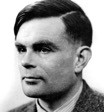Algorithmic Thinking in Art, Design, Science
Frieder Nake
Summer 18, University of Bremen
Tuesday 8:00 to 12, MZH 5210
Starts 10 April 2018
Konrad Zuse (1910-1995)

John von Neumann (1903-1957)

Alan M. Turing (1912-1950)

Vannevar Bush (1890-1974)
Our study program on Digital Media starts from the assumption that computing machinery in the mid-1990s took on media qualities. It became intersesting for academic institutions to start dedicated study progams. Computer science or media departments or faculties decided to do so. Fachhochule Furtwangen in the Black Forrest was the first of those in Germany. They started their Medieninformatik program in 1990. In Bremen, we started a Bachelors and an International Masters program about ten years later.
In a blurb on the infamous Internet about our program, you may read this:
"Communication, work, or leisure time: digital media are changing the world, while at the same time being subject to perpetual change themselves, often at a rapid pace. Only if we learn to live with this process of constant revision will we be able to mold the future according to our needs, both professional and personal."
We should discuss this! But here is something! The computer was invented as a machine for calculations, and it gained its early reputation as a number cruncher. However, KONRAD ZUSE, an engineer who became one of the independent inventors of the computer, developed an early program to play chess already in 1945. ZUSE also designed the first high-level programming language, never really used. And JOHN VON NEUMANN, another giant of early computing, described a program to sort a set of entities for which a total order is defined. Already in 1950, ALAN TURING published his influential paper Computing machinery and intelligence. There he asks whether a machine can think and suggests as a method to answer this question an "imitation game", as he called it, that became known as the Turing test. Speculating at the end of WWII about what to do with the machine that had been constructed during the war, VANNEVAR BUSH wrote a popular paper in July 1945 under the title As we may think. He indicates ideas that much later returned as concepts of hypertext and hypermedia. Earliest text generation and music composition was done with compu-ters in the late 1950s, and since 1965, computer art became an exciting and controversial cultural fact.
Such remarks may suggest that the media aspect and non-mathematical applications have been with the computer from its earliest times. Still, it needed the breakthrough of the Internet in 1994 to generally think of the computer as a medium. (What was behind that break-through?)
Everybody (or, let us say, many) in these days take it for granted that everyone is carrying in their pocket a computer of substantial power. Everyone can be reached at any given point in time. We ask incredibly abstract questions like "Where is that I am?" and expect to get an answer within no time. We don't object against having been reduced from a living human being to a permanent delivery of data. We believe in machines being capable of learning and, perhaps, even in something called the singularity. It promises that soon there will be no diseases any more. At the same time, kids are starving to death and their parents get bombed even though they had nothing to conquer.
The human race is capable of thinking and inventing and discovering and creating and destroying and murdering and torturing and raping like no other species. Our thinking clearly tells us that we must die. We think of our finite existence as individual members of this species of semiotic animal. And therefore, we decide, let us get rid of this finiteness. We believe, some at least do, that together with our invention and manufactured construction, the computer, we will live for ever.
ALGORITHMIC THINKING is different from CRITICAL THINKING and from SPECULATIVE THINKING and from ARTISTIC THINKING. We will try to understand this a bit better. A strong technical workshop on Processing will be embedded into the course.